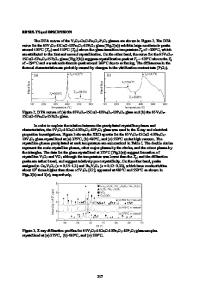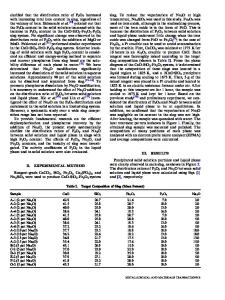FTIR Spectral Characterization, Mechanical and Electrical Properties of P 2 O 5 -Li 2 O-CuO Glass-Ceramics
- PDF / 1,960,180 Bytes
- 10 Pages / 595.276 x 790.866 pts Page_size
- 104 Downloads / 345 Views
ORIGINAL PAPER
FTIR Spectral Characterization, Mechanical and Electrical Properties of P2O5-Li2O-CuO Glass-Ceramics Mohammed A. Taha 1 & Rasha A. Youness 2 & Gehan T. El-Bassyouni 3 & M. A. Azooz 4 Received: 3 June 2020 / Accepted: 18 August 2020 # Springer Nature B.V. 2020
Abstract In the present investigation, X-ray diffraction (XRD), scanning electron microscopy (SEM) and Fourier transform infrared (FTIR) spectroscopy were employed to study the crystallization of (50 P2O5–50 Li2O with different CuO concentrations) glasses. Both mechanical and electrical properties were studied. The results clarified the formation of LiPO3 phase along with Li2CuP2O7 one which became more pronounced with successive increase in CuO contents having in mind that these phases caused measurable increase in density values. Additionally, the fracture toughness, compressive strength and elastic modulus were positively affected by the increasing of CuO contents. Moreover, DC conductivity and activation energy were also dependent on CuO contents where the latter recorded 0.56 eV for sample contained the highest CuO content. On the other hand, AC conductivity was nearly the same at low frequencies for samples had the lowest and highest CuO contents. However, in high frequencies, it showed a noticeable enhancement. Keywords Electrical properties . Mechanical properties . FTIR spectroscopy . Li2O-P2O5 glass-ceramics . Industrial applications
1 Introduction Unlike other oxide glasses, phosphate glasses possess favorable characteristics such as their high ability to dissolve rare earth-earth elements, and have more open structure may allow the incorporation of relatively large amounts without significant clustering effects [1, 2]. Accordingly, they can be extensively used in different industrial and biomedical applications [3]. However, the most well-known and useful property of phosphate glasses is their low melting temperatures, which makes the melting of phosphates less energy and time saving [2]. Unfortunately, despite these brilliant properties, the
* Mohammed A. Taha [email protected] 1
Solid State Physics Department, National Research Centre, 33 El-Buhouth St., Dokki, Cairo 12622, Egypt
2
Spectroscopy Department, National Research Centre, 33 El-Buhouth St., Dokki, Cairo 12622, Egypt
3
Refractories, Ceramics and Building Materials Department, National Research Centre, 33 El-Buhouth St., Dokki, Cairo 12622, Egypt
4
Glass Research Department, National Research Centre, 33 El-Buhouth St., Dokki, Cairo 12622, Egypt
applications of such glasses are restricted due to their low mechanical properties and chemical durability. Therefore, one promising way to overcome these serious problems is to convert these glasses into their corresponding glass-ceramics with the aim of improving both mechanical properties and their chemical durability. Since glass-ceramics have promising thermal, electrical and optical properties, they are highly desirable for industrial and technological applications [4]. Note that some nucleating agents like Fe2O3 [
Data Loading...











